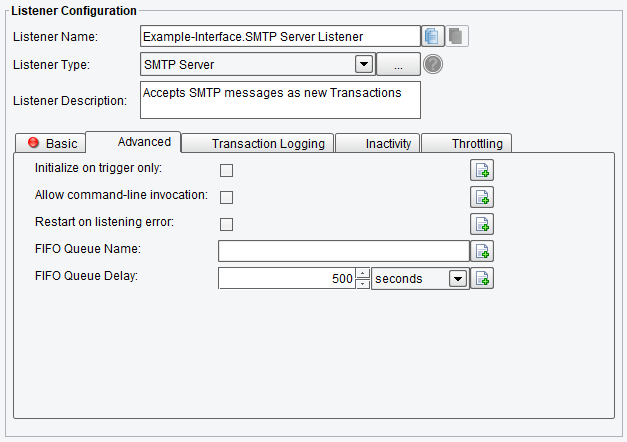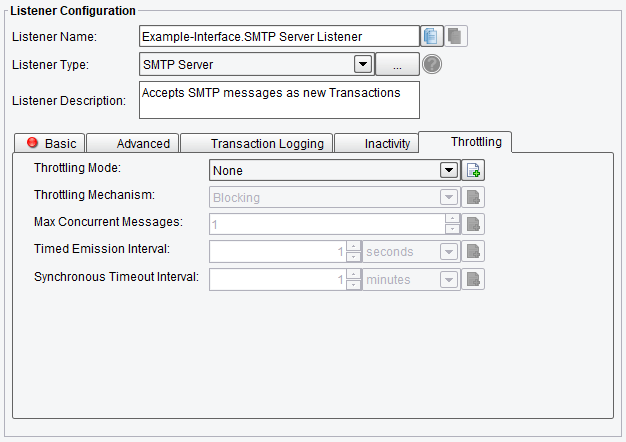SMTP Server Listener
The SMTP (Simple Mail Transfer Protocol) Server Listener accepts SMTP messages as new Transactions. This protocol is primarily used for sending and relaying email messages between servers. SMTP can be leveraged to capture and process incoming emails, extracting relevant data for further automation and integration with other systems.

Listener (Adapter) Configuration Drop-Down List
Basic SMTP Server Listener Configuration Options
On the Basic tab, you can set:
- Server Hostname – the name to respond with for client connections
- Listen Port – the network port to receive connections on
- White List – accept connections from these hosts
- Use TLS – the options to set the Transport Layer Security (TLS) are None, Optional or Required

SMTP Server Listener Basic Configuration Options
Advanced SMTP Server Listener Configuration Options
On the Advanced tab, you can set:
- Initialize on Trigger Only – if enabled, the Listener doesn’t start up until a trigger initializes it
- Allow Command-line Invocation – if enabled, the Listener can be invoked using the CLI client application
- Restart on Listening Error – if enabled, the Listener will be restarted after an error occurs
- FIFO Queue Name – the FIFO option enables a “First In, First Out” queuing mechanism between Listeners and Transports. If a FIFO Queue Name is provided, it will be used as a key for a transaction queue. Transactions will be written to this queue before they reach a Transport. The transactions in this queue will be ordered according to when the Listener created them.

SMTP Server Advanced Listener Configuration Options
SMTP Server Listener Transaction Logging Configuration Options
On the Transaction Logging tab, you can enable transaction events logging. That data can be logged by a Transaction Event Listener (TransactionEventListener).
- Transaction Logging Enable – this checkbox allows transaction events originating from this Listener to be logged by a Transaction Event Listener (TransactionEventListener)
- Log Transaction Data – if enabled, logs transaction data body
- Log Transaction Data Base64 – if enabled, logs transaction data body as Base64
- Log Transaction Attribute – if enabled, logs transaction attributes
- Log All Attributes – if enabled, no attributes will be filtered out
- Allowed Attributes – attributes that are allowed to be logged

SMTP Server Listener Transaction Logging Configuration Options
SMTP Server Listener Inactivity Configuration Options
On the Inactivity tab, you can specify:
- Enable Inactivity Monitor – check this box to enable inactivity monitoring – this will throw a non-transaction exception if the specified number of transactions haven’t been processed in the specified time interval
- Minimum Transactions to Expect – the number of transactions to expect to be completed per monitoring interval
- Monitoring Interval – how often to check that the specified number of transactions have been processed
- Times to Monitor – if set, monitoring will be done during the defined times of day – to ignore, set start and end times equally
- Days to Exclude from Monitoring – inactivity monitoring will not occur on the days specified
- Include Errors in Transaction Count – if checked, transactions that attempted to start but failed at the Listener stage will also be counted

SMTP Server Listener Inactivity Configuration Options
SMTP Server Listener Throttling Configuration Options
On the Throttling tab, you can specify the following configuration options:
- Throttling Mode – the throttling mode to use for limiting the number of transactions or messages emitted by this Listener. Timed will limit transactions based on time intervals, while Concurrent will limit transactions based on a concurrent number of transactions. The concurrent mode requires a Throttling Response Processor step later in your Interface workflow to acknowledge completion.
- Throttling Mechanism – the mechanism to use for throttling messages – Blocking prevents the Listener from continuing to process and emit messages altogether, while Queued pushes received messages into the Interface queue or a default, in-memory queue.
- Max Concurrent Messages – how many messages can be concurrently processed, either by time-based limits (allow X per second) or synchronous (allow X at any time)
- Timed Emission Interval – the interval for time-based limits (allow X per X Timed Emission Interval)
- Synchronous Timeout Interval – the interval to wait for a synchronous response before failing

SMTP Server Listener Throttling Configuration Options
